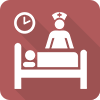- Signs and Symptoms of Xanax Abuse
- Combining Xanax with other Substances
- How are Disorders Diagnosed?
- Who is At Risk for Addiction?
- When to Seek Help
- Help for Addicted Friends and Family
- Xanax Rehab Options
- Withdrawal from Xanax
- Treatment Techniques and Modalities
- Teen Xanax Abuse and Addiction
What is Xanax Abuse?
Xanax is a benzodiazepine type of sedative commonly used in psychiatric treatment for stress, anxiety, panic and insomnia.
It induces a sense of well-being, calm, and relaxation in the user.
Xanax abuse can lead to serious consequences. It can cause physical addiction with severe cravings and medically complicated symptoms of withdrawal.
Xanax is the pharmaceutical brand name for alprazolam. It is a controlled substance that is considered abusable, mood-altering and addictive.
It is estimated that approximately 50 million prescriptions for Xanax (or the generic
alprazolam) are written every year in the US.
After extended use, many people believe themselves unable to cope without it. Continuous use creates a psychological addiction that is difficult to overcome.
Signs and Symptoms of Xanax Abuse
Xanax is fast acting. Its usual effects are similar to alcohol and include:
- Sedation.
- Decreased anxiety and panic.
- Relaxation.
- Euphoria.
- Lowered inhibitions.
Xanax can temporarily boost confidence and help ease a usually difficult performance or social interaction. These effects can cause psychological reliance upon Xanax as a coping strategy for life's challenges.
Misuse results in intoxication.
Signs of Xanax intoxication can include:
- Slurred speech.
- Impaired co-ordination.
- Confusion.
- Unsteady gait.
- Drowsiness.
- Blurred vision.
- Slowed breathing.
- Memory loss.
- Dizziness.
- Slowed reactions.
- Slowed heart beat.
- Fainting.
- Feelings of body weakness.
- Unconsciousness.
If you or someone close to you is struggling with Xanax addiction, even thinking about getting help can be overwhelming.
If you don't know where to begin, call our addiction recovery helpline at
1-888-993-3112Who Answers? for more information about your treatment options.
Combining Xanax with other Substances
Xanax is frequently used along with other drugs for enhanced intoxication.
Common high-risk combinations are Xanax with alcohol or opioids. All three substances are central nervous system depressants that interact to increase the depressant effects of each other.
Indications of intoxication include:
Unconsciousness and death from cardiac or respiratory can occur when mixing Xanax with other substances.
- Staggering.
- Slurred speech.
- Poor coordination.
- Memory loss.
- Disorientation.
Unconsciousness and death due to cardiac or respiratory depression can occur.
Xanax is one of the most common drugs used in combination with opioids such as heroin, oxycodone, and Vicodin.
It is also a common drug of abuse among those in Methadone treatment. Those who combine Xanax with opioids tend to have used the opioid over long periods of time and in higher than average doses.
Research indicates that they typically have poorer overall health and legal problems as well as a history of other addictions such as to alcohol or cocaine.
How are Disorders Diagnosed?
 Narcotics Anonymous offers a 12-step recovery program for those struggling with Xanax abuse and other substances. Find a meeting for you or your loved one.
Narcotics Anonymous offers a 12-step recovery program for those struggling with Xanax abuse and other substances. Find a meeting for you or your loved one.
Xanax Use Disorder is a medical diagnosis given when one has negative consequences of Xanax use across various realms of one's life.
These consequences include:
- Physical symptoms.
- Problematic behaviors.
- Negative consequences in the management of one's life overall.
With extended use, physical tolerance for Xanax develops, and higher doses or more frequent use is needed to achieve the desired effects.
This is accompanied by cravings and urges to use Xanax, as well as withdrawal symptoms if one's dose is lowered or use is stopped.
Strong urges that are overwhelming and difficult to resist cause compulsive behavior and continued use.
According to the American Psychiatric Association (2013), some compulsive behaviors in a Xanax Use Disorder are:
- Taking more Xanax than usual and spending a lot of time being preoccupied by thoughts of using, or getting Xanax.
- Giving up family, social, occupational, academic or recreational activities because of use.
- Using Xanax in a physically hazardous situation such as driving or operating machinery.
A Xanax Use Disorder creates a loss of control and unmanageability in one's life overall. Some examples are:
- Continuing to use Xanax even when it compromises health, safety, relationships, employment or other important areas of life.
- Wanting to cut down or stop using Xanax but not managing to.
- Not managing to do what you should at work, home or school, because of Xanax use.
- Continuing to use, even when the you know you have a physical or psychological problem that could have been caused or made worse by Xanax.
Who is At Risk for Addiction?
Anyone who uses benzodiazepines like Xanax for an extended time can become addicted. There are those at particularly high risk, however.
They include:
- Individuals with a history of substance use problems or who are currently abusing another substance.
- Those who have mental health conditions such as:
- People with chronic pain.
- Those treated with methadone and buprenorphine for opiate addictions.
- Individuals abusing or addicted to opioids.
- Abstinent alcoholics.
When to Seek Help
Some common indicators that you need professional help include:
- Feeling out of control and unable to manage your life due to Xanax use.
- Requiring greater amounts of Xanax in order to feel the way you want to feel.
- Running out of your prescription early.
- Incurring significant losses because of Xanax use--family, job, home, finances, friends, etc.
- Using a combination of drugs to get a desired effect.
- Doctor shopping (seeking multiple sources of prescriptions for Xanax).
- Having symptoms of mental decline such as confusion, memory loss and disorientation.
- Having withdrawal symptoms when taking a lowered dose.
Help for Addicted Friends and Family
Your loved one is in a state of distress and has difficulty concentrating, processing information, making decisions and solving problems.
Consequently, you may need to help navigate admission to a treatment program if that help is wanted.
You should act quickly whenever your friend or family member agrees to go to treatment for Xanax abuse.
It is important to have reasonable expectations and to set limits on how involved you can be, particularly if your loved one does not pursue recovery.
Becoming informed about Xanax addiction and options for treatment will prepare you to discuss your concerns with your loved one effectively.
The concern, kindness and compassion that you would have for any other seriously ill individual is also appropriate for an addicted loved one.
Xanax Rehab Options
Treatment options for Xanax Use Disorders are varied across a range of settings. These include inpatient, residential, partial hospitalization, and outpatient treatment options. A choice should be made with your individual needs in mind. It is helpful to discuss this with an addiction professional.
Outpatient vs. Inpatient

Outpatient
Outpatient sessions--individual and group--are typically scheduled on a weekly basis and take place in an office or clinic setting. It is important to consider whether outpatient treatment can provide you adequate help at the onset of your recovery efforts.

Inpatient
Many choose instead to leave home to have more structure, more support and a respite from the daily life in which the Xanax addiction developed. The severity of use and the time used are also considerations when choosing between outpatient or inpatient settings. You may also need inpatient treatment to withdraw safely and detox from Xanax.
Partial Hospitalization or Intensive Outpatient
 Participants attend therapy sessions for some hours per day, usually several days per week. There may be occasional appointments for medical care. However, this varies between programs. This option allows you to live at home while having more support than an outpatient program.
Participants attend therapy sessions for some hours per day, usually several days per week. There may be occasional appointments for medical care. However, this varies between programs. This option allows you to live at home while having more support than an outpatient program.
Residential Treatment Centers
 Residential centers are beneficial for those who need a lengthier period away from the community to gain momentum in their recovery. Stays are typically in 30-day increments. Some residential centers provide luxury accommodations in resort or spa-like environments. Others accommodate the needs of executives who must stay in touch with the business world.
Residential centers are beneficial for those who need a lengthier period away from the community to gain momentum in their recovery. Stays are typically in 30-day increments. Some residential centers provide luxury accommodations in resort or spa-like environments. Others accommodate the needs of executives who must stay in touch with the business world.
Withdrawal from Xanax
Medical monitoring is important during withdrawal due to the possibility of serious health complications.
Withdrawal and detox require medical supervision, and protocols vary to accommodate individual needs. Medical monitoring is important during these protocols due to the possibility of serious health complications.
In cases where use has been severe and prolonged an inpatient setting with 24 hour medical monitoring and supervision is typically recommended.
This can take place in a hospital or treatment center that provides medical services for withdrawal and detoxification.
Treatment
Beyond withdrawal and detox, Xanax recovery includes learning to live successfully without use. Counseling and education to that end can be done in various treatment settings through individual, group and family sessions.
Typically these sessions address:
- Xanax addiction and recovery education.
- Emotional and psychological impact of the addiction.
- Reparation of strained relationships.
- Issues of loss and grief related to the addiction.
- Co-occurring issues such as depression, anxiety, trauma.
- Identification of triggers to use.
- Identification of alternate coping strategies.
- A relapse prevention plan.
- A plan for re-entering life in the community and sustaining abstinence.
Treatment Techniques and Modalities
Xanax Use Disorder is treated with a variety of methods and it is common for treatment in all settings to include a core combination of the following:
- Supportive counseling:
- Enhances a sense of well-being, self-esteem and empowerment for effecting and maintaining change.
- Cognitive behavioral therapy (CBT):
- Addresses the connection between one's thoughts, beliefs, feelings and behaviors involved in addiction in order to substitute healthier, more helpful ones.
- Motivational interviewing:
- Mobilizes one's insights, resources and actions needed for change.
- Psychological education and skills:
- For help with:
- Stress management.
- Anger management.
- Relationship building.
- Assertiveness.
- Substance-free coping strategies.
- Increases awareness of addiction dynamics and relapse prevention strategies.
Teen Xanax Abuse and Addiction
The top 3 substances abused by teens 14 years and older are:
- Alcohol.
- Marijuana.
- Prescription drugs.
Multi-drug use is common among teens that abuse substances and Xanax is often dangerously combined with alcohol and marijuana.
Mixing of drugs increases the likelihood of lethal consequences.
The prevalence of Xanax prescriptions used in the US gives teens easy access in their homes and the homes of relatives and peers.
It is estimated that 1 out of every 10 teens has used a prescription drug non-medically.
1 in 10 teens has used a prescription drug non-medically.Teens at high risk for Xanax abuse and addiction are those who are:
- Living in homes with easily accessed Xanax.
- Have disengaged parents.
- Have peers who use.
There are
treatment programs designed specifically for teens that abuse or are addicted to Xanax.
Please call our toll free line at
1-888-993-3112Who Answers? to speak to a treatment support team member about such Xanax treatment options.



